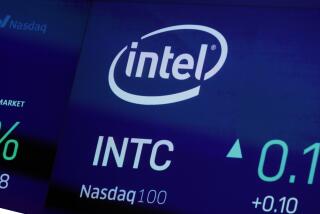Intel Pulls Out of Consumer Electronics
- Share via
Intel Corp. said Friday that it is pulling the plug on its consumer electronics to focus on its core semiconductor operations.
The Santa Clara, Calif.-based chip maker cited insufficient long-term growth as the reason for shuttering the unit that makes digital toys, cameras and portable music players. The company has enough inventory to sell through the holiday season and into early next year but has stopped making new products.
“While we’ve had some success, the business as a whole simply doesn’t meet our requirements for long-term growth,” said Intel spokesman Bill Calder, who did not specify growth targets. “Our core business is silicon.”
The decision reflects Intel’s efforts to retrench during a difficult downturn in the market for personal computers, most of which are powered by Intel microprocessors.
The company also has been hurt by sharp cutbacks in corporate spending on communications and networking equipment, two markets in which Intel has significant presence. This week, Intel reported a 96% plunge in third-quarter profit as sales slipped 25% to $6.5 billion.
Intel’s exit from consumer electronics will affect about 100 employees, most of whom are based in Oregon. They will be offered other jobs at Intel or a severance package. Intel employs 86,000 workers worldwide, 14,000 of whom are in Oregon. Earlier this year, Intel announced plans to cut 5,000 positions by year’s end, primarily through attrition.
Calder said the decision does not affect Intel’s home networking products, which allow consumers to extend their Internet connection to multiple devices within a home.
Intel went into the consumer electronics business in 1997 with its PC camera as a way to seed the market with gadgets that connect to the PC, Intel’s mainstay business. The company expanded into digital toys in 1998 in a joint venture with Mattel Inc. After releasing a digital microscope and a sound morpher, Mattel left the venture last year, saying it didn’t want to be limited to products that require a PC.
Intel declined to say how much it spent launching a consumer products unit or how much the division pulls in. Richard Doherty, research director of Envisioneering Group, a consulting firm in Seaford, N.Y., said the unit’s revenue represents less than 1% of Intel’s $30 billion in annual sales.
Intel achieved modest success in its foray into consumer electronics. Its Web camera and Pocket Concert digital music player were top sellers in their categories in July, according to NPD Intelect, a market research firm in Port Washington, N.Y. The camera is the only profitable product in the division.
Industry experts weren’t surprised that Intel pulled out of the fiercely competitive consumer electronics market.
“Those products are commodities in that they have extremely low profit margins,” said Bob O’Donnell, research director for IDC in Mountain View, Calif. “Perhaps they knew that when they got into the business, but times have changed, and the demands on Intel are such that they probably decided it was no longer worth keeping.”
Intel shares gained 10 cents to $24.15 in Nasdaq trading Friday.
More to Read
Inside the business of entertainment
The Wide Shot brings you news, analysis and insights on everything from streaming wars to production — and what it all means for the future.
You may occasionally receive promotional content from the Los Angeles Times.











